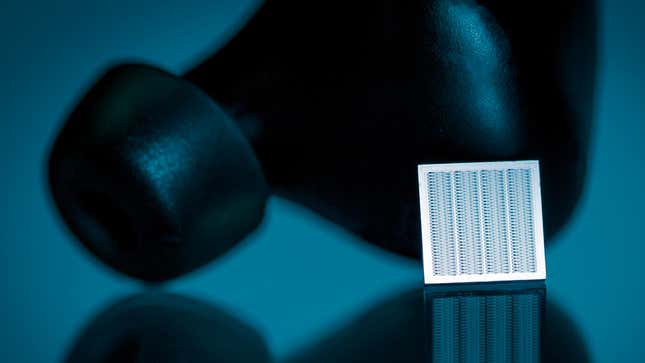
Wireless earbuds could soon be small enough to be completely unnoticeable when worn thanks to a new design for a microspeaker made entirely from silicon. This approach replaces traditional speaker designs relying on magnets and moving membranes. The new sound-producing chips could dramatically improve battery life as well, making these devices less dependent on charging cases.
In just a few short years, wireless earbuds have gone from being expensive, bleeding edge accessories that were less-than-comfortable to wear to being affordable, discreet, and with sound quality and features that rival larger over-ear headphone alternatives. There’s still lots of room for wireless earbuds to improve, however, and one of the things holding them back has been the use of tiny speakers that function almost identically to the first loudspeakers that inventors like Edison created almost 150 years ago: an electromagnet causes a thin membrane to vibrate back and forth which pushes the air to create sound waves that our ears interpret as sounds.
If it’s not broke, don’t fix it, but a German startup named Arioso Systems (a company that spun off of the Fraunhofer Institute for Photonic Microsystems) believes it’s come up with a different and better approach to generating sound on a much smaller scale—something it calls a Nanoscopic Electrostatic Drive (NED, for short) microspeaker that does away with magnets and a moving membrane altogether.

Human hearing is still dependent on detecting sound waves traveling through the air, so the Arioso Systems’ NED chip has replaced a traditional speaker’s vibrating membrane with a series of thin beams inside, each measuring just 20 micrometers in length, that bend and flex when a voltage is applied. The movement of the beams pushes air out through a series of vents on the front and back of the chip, creating pressure fluctuations within the ear that in turn move the eardrum, creating audible sounds.
The tiny footprint of the NED microspeaker chip isn’t its only advantage. Made entirely from silicon they’re also easy and affordable to mass produce using existing manufacturing techniques, and the simplistic moving parts will extend the battery life of wireless earbuds by several hours, its creators claim. Given how the new microspeaker works by creating pressure fluctuations within the ear it will probably work best with in-ear wireless earbuds that use silicone ear tips to create an airtight seal when worn, but that seems like a minor trade-off if it manages to alleviate battery life anxieties.